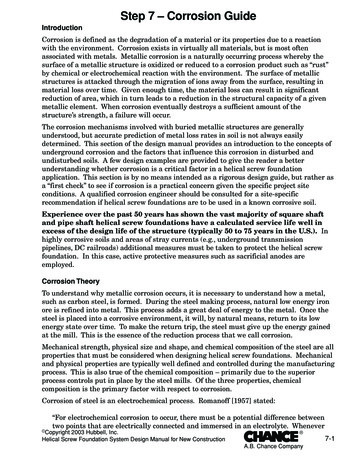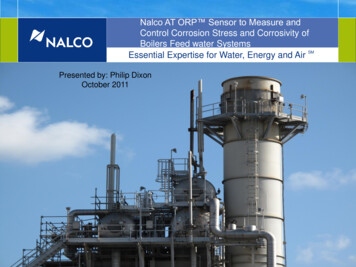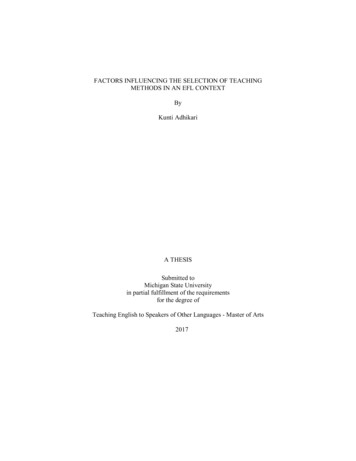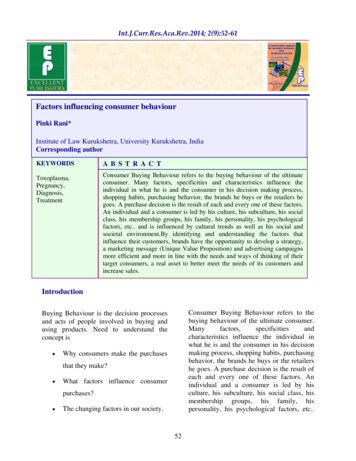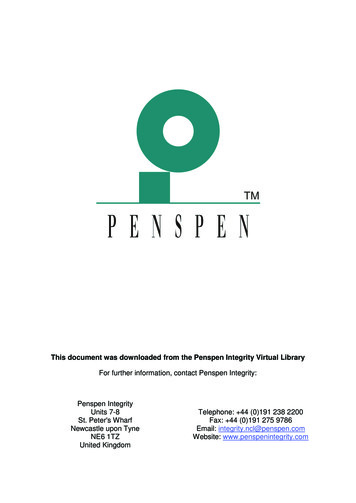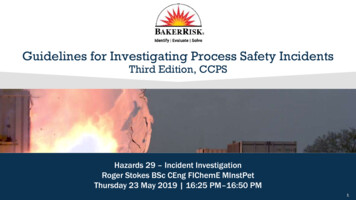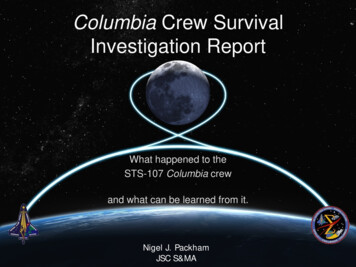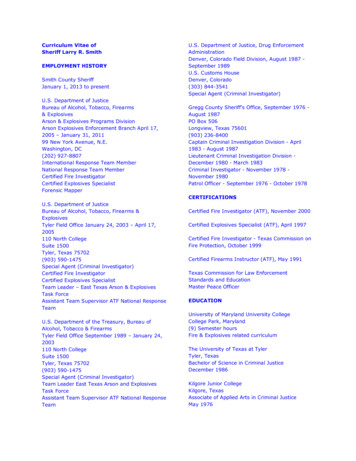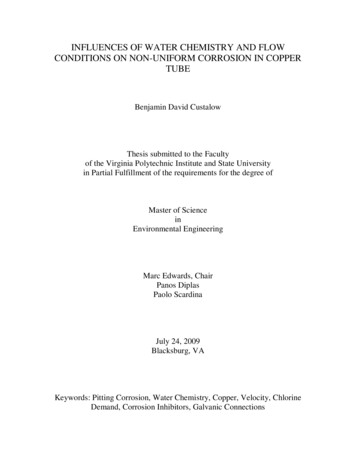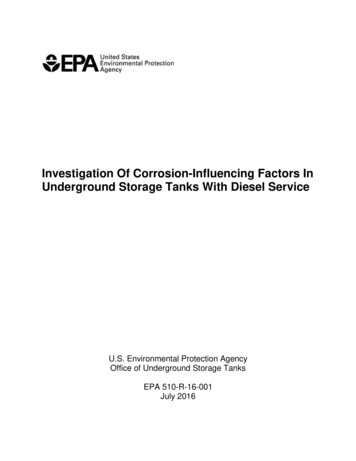
Transcription
UST Corrosion InvestigationDate: 6/1/2015Version: DRAFTPage 1 of 38Investigation Of Corrosion-Influencing Factors InUnderground Storage Tanks With Diesel ServiceU.S. Environmental Protection AgencyOffice of Underground Storage TanksEPA 510-R-16-001July 2016
AcknowledgmentsBattelle, under the direction of the United States Environmental Protection Agency(EPA) through Scientific, Technical, Research, Engineering and Modeling Support (STREAMS)II Task Order 0016 of Contract EP-C-11-038, conducted this research with EPA’s Office ofUnderground Storage Tanks (OUST). EPA thanks Battelle and all of the volunteer partners whoallowed us access to their underground storage tanks and related documents. EPA alsoappreciates the insight and comments from individuals and industry representatives whoprovided valuable input on the research plan and draft report.ii
ContentsSupplements . ivFigures. ivTables . ivList Of Abbreviations And Acronyms .vExecutive Summary .1Chapter 1: Introduction And Background.5Chapter 2: Methodology .12I. Information Gathering .12A. UST System Background Information .15B. On-Site Inspections And Corrosion Classification .16II. Sample Collection .17III. Sample Analyses .18IV. Statistical Analysis Approach .19Chapter 3:I.II.III.Observations And Results .21Corrosion Observations In USTs Storing Diesel .21Corrosion Coverage Classification Process .26Analytical Results.30A. Quality Assessment And Oversight .30B. Vapor Analytical Testing And Results .30C. Aqueous Phase Analytical Testing And Results .33D. Fuel Analytical Testing And Results.34Chapter 4: Statistical Analysis Procedure And Results .40Chapter 5: Discussion Of Results .48I. Corrosion Process .48II. Feasibility Of Previous Hypotheses About Biofuels And MIC .52Chapter 6: Key Takeaways .55iii
SupplementsSupplement A:Supplement B:Supplement C:Supplement D:Supplement E:Quality Assurance Project PlanData TablesQA/QC Data TablesStatistics CodebookQuality Assessment And OversightFiguresFigure 1.Figure 2.Figure 3.Figure 4.Figure 5.Figure 6.Figure 7.Figure 8.Figure 9.Figure 10.Figure 11.Figure 12.Figure 13.Figure 14.Simplified Diagram Of Diesel UST System Equipment .8Summary Of 42 UST Systems By Capacity And Material .13Locations Of Clusters Of USTs In Study Population.13Forty-Two USTs By Corrosion Category And Material .21UST System 9-IN-FG STP Shaft Corrosion .25UST System With Fiberglass Tank With Minimal Metal Corrosion .27UST System With Steel Tank With Minimal Metal Corrosion .28UST System With Fiberglass Tank With Severe Metal Corrosion .28UST System With Steel Tank With Severe Metal Corrosion .29Random Forest Analysis And OOB Accuracy Assessment Results Of EachVariable Evaluated Individually According To Three Corrosion Categories .43Random Forest Analysis And OOB Accuracy Assessment Results Of EachVariable Evaluated Individually According To Minimal And Moderate SevereCategories .44Random Forest Analysis Results Of Each Variable Evaluated IndividuallyAccording To Three Corrosion Categories And Including The Acidic HydrogenVariable .47Relative Corrosion Rate Versus pH And Temperature Of Carbon Steel In Water .51Potential Versus pH Equilibrium Diagram For Aluminum.51TablesTable 1.Table 2.Table 3.Table 4.Table 5.Table 6.Table 7.Table 8.UST Equipment Reported Most Frequently Experiencing Operational ProblemsIn Additional Comments Of 2010 Survey .7Analytical Methods By Sample Type .20Characteristics And Corrosion Coverage Of USTs Inspected For This Research .23Vapor Results In Order Of Corrosion Classification And Increasing Acetic AcidConcentration .32Aqueous Phase Results In Order Of Corrosion Classification And IncreasingAcetic Acid Concentration .36Fuel Results In Order Of Corrosion Classification And Increasing ParticulateContamination .37P-Value Rankings From The Ordered Logistic Regression For The VariablesFor All 42 USTs .45Statistical Results Acidic Hydrogen Using ANOVA .46iv
Abbreviations And AcronymsALSANOVAAPIASTMATGATRALS Environmentalanalysis of varianceAmerican Petroleum InstituteASTM Internationalautomatic tank gaugeattenuated total reflectanceCDFACRCClean Diesel Fuel AllianceCoordinating Research CouncilDNAdeoxyribonucleic acidEGTEPAemergency generator tankEnvironmental Protection AgencyFAMEFIDFTIRfatty acid methyl estersflame ionization detectorFourier transform infraredGC-MSgas chromatography-mass spectrometryICIDion chromatographyidentificationLLOQLSDliterlimit of quantitationlow sulfur dieselmg/kgmg KOH/gmg/LMICmm HgMRLmS/cmmilligrams per kilogrammilligrams potassium hydroxide per grammilligrams per litermicrobiologically-influenced corrosionmillimeter of mercurymethod reporting limitmillisiemens per centimeterNACENAVFACNIOSHNational Association of Corrosion Engineers InternationalNaval Facilities Engineering CommandNational Institute for Occupational Safety and HealthOOBORDOUSTout of bagOffice of Research and DevelopmentOffice of Underground Storage TanksPEIPetroleum Equipment Institutev
PLSPOMppbvppmpS/mpartial least squarepolyoxymethyleneparts per billion by volumepart per millionpicosiemens per meterQAQAPPQCquality assuranceQuality Assurance Project Planquality controlRFSRenewable Fuel StandardSTPSTREAMSSWsubmersible turbine pumpScientific, Technical, Research, Engineering and Modeling SupportEPA Test Methods for Evaluating Solid WasteTANtotal acid numberULSDUSUSTultra-low sulfur dieselUnited Statesunderground storage tankvi
Executive SummaryInvestigation Of Corrosion-Influencing Factors In Underground Storage TanksWith Diesel ServiceThis research focused on better understanding a type of rapid and severe corrosion ofmetal components in underground storage tanks (USTs) storing diesel fuel. UST owners firstbegan reporting this corrosion to UST industry servicing companies in 2007. Several changes tothe national fuel supply and fuel storage practices have occurred since the mid-2000s. Toaddress the potential for corrosion problems, the U.S. Environmental Protection Agency’s (EPA)Office of Underground Storage Tanks began working on this research in 2014 to understand howserious and widespread the metal corrosion problem could be. In addition, to help identify thecause or solutions, we wanted to identify predictive factors between UST systems with corrosionissues and UST systems relatively free of the problem. EPA’s objective for the research was todevelop a better understanding of potential risks to human health and the environment caused bythe evolving corrosion problem in USTs storing diesel fuel.In 2014, EPA held discussions with UST industry experts and worked collaboratively todevelop field-based research that would further the understanding of corrosion inside USTsstoring diesel. EPA designed our research to examine many factors on a diverse population of42 UST systems in order to find potential predictive factors among them. We thought anypredictive factors identified in our research would help focus the search of potential causes forthe next phase of follow-on research.In January and February 2015, EPA conducted on-site inspections of 42 diverse,operating UST systems at 40 sites across the country. Of these UST systems, 24 had fiberglasstanks, and 18 had steel tanks. Field teams documented the conditions of the UST systems within-tank video cameras and photos so they could later assign a category of corrosion coverage toeach system. The field teams also collected samples of vapor, fuel, and aqueous phase (alsoknown as water bottom), if present, from each of the tanks. Field teams used a detailedquestionnaire to gather information from each owner about the storage history, operation, andmaintenance practices of each UST system.EPA chemically analyzed the vapor, fuel, and aqueous phase samples. Three assessorsreviewed the videos of each UST and categorized the USTs by the extent of the corrosion judgedto be present: minimal, moderate, or severe. In an attempt to identify corrosion predictingfactors among UST systems experiencing either minimal corrosion or severe corrosion, we thenstatistically evaluated the analytical results and responses from the questionnaires against thecorrosion categories.The major finding from our research is that moderate or severe corrosion on metalcomponents in UST systems storing diesel fuel in the United States could be a very commonoccurrence. Observations suggest that corrosion may be commonly severe on metal surfaces inthe upper vapor space of UST systems, an area that before 2007 was not known to be prone tocorrosion. Furthermore, it appears many owners may not be aware of the corrosion nor are theyaware that corrosion, which could affect the operability of their UST systems, could already be at1
an advanced stage. We observed 83 percent of the inspected tanks had moderate or severe metalcorrosion. Prior to our research inspections, less than 25 percent of owners reported knowledgeof corrosion in their UST systems.It appears from our research that corrosion inside of UST systems could result in anincreased chance of releases of fuel to the environment and subsequent groundwatercontamination. Across the sample population, EPA observed corrosion occurring on all types ofUST system metal components, including submersible turbine pump shafts, automatic tankgauge probe shafts, risers, overfill equipment like flapper valves and ball valves, bungs aroundtank penetrations, inner walls of tanks, and fuel suction tubes. Many of these UST systemcomponents are designed to prevent overfilling the tank or to identify leaks, and the componentsmust be able to move and function as designed. Corrosion of some metal components couldhinder their proper operation and possibly allow a release of fuel to occur or continue unnoticed.Anecdotal reports since EPA began our research suggest that other metal components in USTsystems, such as tank walls, could also eventually fail by corroding completely through the metalif corrosion is not stopped. This would most likely occur in the bottom of an UST whereaqueous phase and tank sludge collect. Corrosion through the bottom or wall of a tank couldpotentially allow fuel to leak into secondary containment areas or release to the environment.EPA has heard anecdotes of functionality failures of release prevention equipment andleak detectors, as well as failures of metal walls resulting in leaks into secondary containmentareas. Outside of anecdotes, however, very little verifiable data exists about how equipmentfunctionality and integrity are being affected by corrosion in USTs storing diesel fuel. However,that information should become more available as owners become more aware of the findings ofour research and corrosion in USTs storing diesel becomes more visible.Even absent a release of fuel to the environment, severe corrosion poses concerns forowners. Corrosion increases servicing and equipment maintenance costs for UST systemowners. Anecdotes suggests that dispenser filters may become clogged with corrosion debristhat resembles coffee grounds, resulting in filters needing to be changed more frequently. Otherequipment may need to be repaired more often and sometimes may need to be prematurelyreplaced.The data and analyses could not pinpoint a cause of corrosion that UST owners beganreporting in 2007. It appears multiple underlying factors and corrosion mechanisms could becontributing to the corrosion; one such mechanism is microbiologically-influenced corrosion(MIC). Previous research on the recent corrosion phenomenon is limited, but suggests that thereduced sulfur in diesel could be allowing microbial life to proliferate in ultra-low sulfur dieseltanks and, through MIC, cause corrosive conditions that were less possible in USTs storing lowsulfur diesel. Several independent organizations have produced publicly available resources thatsuggest following certain enhanced maintenance practices when storing diesel fuel in USTs. Iffollowed, these practices can likely minimize MIC risks by reducing bacterial populations orpreventing an environment where microbial life can thrive.EPA’s research builds on industry’s first study about rapid and severe corrosion in USTsstoring diesel, which the Clean Diesel Fuel Alliance (CDFA) completed in 2012.1 The objective2
of CDFA’s study was to produce an initial hypothesis about the mechanism of corrosion fromdata collected on six UST systems. EPA’s Office of Research and Development (ORD)completed research shortly after CDFA.2 Both the CDFA and ORD research hypothesized thatbiofuel components in diesel, such as ethanol and biodiesel, could be providing the energysource for microbial populations of bacteria like Acetobacter in USTs. This genus of bacteriawas the most abundant in samples that underwent DNA sequencing in CDFA’s study. EPA’sresearch plan to identify any predictive factors by default included checking the plausibility ofthe hypotheses previously suggested. However, there are numerous other types of bacteria thatcould also be consuming chemical components of the fuel or fuel contaminants found in USTs.In addition to bacteria, there are also a number of other microorganisms that could cause orcontribute to the corrosion attacks, including fungi, archaea, and eukaryotic organisms. Acombination of one or more of these factors could also be responsible, but we did not test forthose factors in our research.Because only limited scientific research was available, EPA assumed from the beginningof our research that, within our research scope, it was not feasible to definitively pinpoint a causeof the corrosion. Further, most familiarity with the extent and geographic spread of the problemwas anecdotal. Therefore, an exploratory approach was most helpful in expanding theknowledge around the issue. Our research suggests that MIC is likely involved in the moderateor severe internal corrosion in USTs storing diesel. However, further identification of specificbacteria was not possible within the scope of our research. Therefore, while previous researchhypotheses about the role of specific species of a genus oxidizing biofuel components were notdisproven by the results of our research, validation would be speculative.EPA’s research population of 42 USTs was geographically, materially, and operationallydiverse and was the largest field research of this issue to date. However, the population is asmall percentage of diesel USTs across the United States, and the types of USTs andmaintenance practices by owners in the research population may differ from those in the nationalpopulation of USTs storing diesel. Therefore, EPA cannot predict if the presence of moderate orsevere corrosion in diesel USTs across the United States will be higher or lower than identifiedin our research.EPA recommends owners check their diesel UST systems for corrosion and take steps toensure the proper operability of their UST systems. EPA is recommending this because 83percent of USTs in the study affected by moderate or severe corrosion is very high, most of theowners were not aware of the extent of the corrosion in their USTs, and it appears that corrosioncould potentially affect equipment functionality and potentially lead to a release of fuel to theenvironment.Our research provided us with key takeaways that, by increasing the knowledge aroundcorrosion, may help prevent releases of diesel fuel from UST systems. Below we list our keytakeaways; see Chapter 6 for additional discussion about them. Corrosion of metal components in UST systems storing diesel appears to be common. Many owners are likely not aware of corrosion in their diesel UST systems.3
The corrosion is geographically widespread, affects UST systems with steel tanks andwith fiberglass tanks, and poses a risk to most internal metal components. Ethanol was present in 90 percent of 42 samples, suggesting that cross-contamination ofdiesel fuel with ethanol is likely the norm, not the exception. The quality of diesel fuel stored in USTs was mixed. Particulates and water content in the fuel were closest to being statistically significantpredictive factors for metal corrosion, but causation cannot be discerned. MIC could be involved as hypothesized by previous research. EPA recommends owners visually inspect USTs storing diesel as part of routinemonitoring.4
Chapter 1Introduction And BackgroundThe U.S. Environmental Protection Agency (EPA) Office of Underground Storage Tanksis responsible for ensuring that, in order to prevent releases and avoid contaminating vitalunderground water supplies, fuels and hazardous substances are safely stored in undergroundstorage tank systems (USTs). This report describes the process and results of EPA’s research tounderstand the extent, severity, and potential impacts of severe and rapid corrosion occurring inUSTs storing ultra-low sulfur diesel (ULSD), hereafter referred to as diesel, that has beenreported across the country since soon after the fuel was introduced in 2006. Our research alsoattempted to identify predictive variables that could narrow the search of possible causes of andsolutions for the corrosion of metal components in UST systems storing diesel fuel.EPA is working proactively with industry to help solve the problem because someanecdotes about the severe or rapid corrosion reported compromised functionality and failure ofsome metal components of UST systems. If corrosion prevents UST system equipment fromfunctioning properly, then UST systems may be at higher risk of operational failures, whichcould result in the release of fuel into the environment. EPA heard anecdotes about newsubmersible turbine pumps that were replaced due to corrosion in as few as six months afterbeing installed. Reports of UST system components corroding with this combination of speed,severity, and location within the vapor spaces of USTs were not reported prior to 2007.EPA worked with industry experts to design our field research, which built on the CleanDiesel Fuel Alliance’s (CDFA) 2012 research findings. EPA contracted with Battelle to executethe work. We designed our research to be exploratory in nature, examining data from 42operational USTs storing diesel. The goals of the research were twofold: to understand theextent, severity, and potential risks of the corrosion; and to identify any predictive factorsbetween UST systems with severe corrosion issues and UST systems relatively free of theproblem. We wanted to identify predictive factors so they could help narrow the scope ofinvestigation for future research efforts. EPA appreciates the efforts of our contractor, industrypartners and stakeholders, as well as volunteer UST owners, who helped make our researchpossible.New And Historical Trends In Corrosion In USTs Storing DieselThe first known report of severe corrosion on internal metal components in the vaporspace of an UST system storing diesel was posted on the Petroleum Equipment Institute’s (PEI)website in 2007.3 This location of corrosion in USTs storing diesel fuels has since beencommonly reported, with anecdotes often describing the corrosion as severe and sometimesoccurring rapidly on new equipment.Prior to 2007, corrosion risks identified in tanks storing diesel fuels were generallythought to be limited to the bottoms of tanks and were not observed in upper portions of tanks.The risk of corrosion in the bottoms was usually considered to be easily addressed with goodUST system maintenance practices. The corrosion observed since 2007, however, may affectowners who have followed the same maintenance practices for years and previously had no5
corrosion issues. Reports of the corrosion of metal components in the upper portions of USTsindicate the functionality of metal components of UST systems can be compromised. EPA andthe fueling industry do not yet understand the exact cause of the corrosion nor its full effects onequipment.Unchecked corrosion in UST systems could result in a potentially higher risk of anenvironmental release and subsequent groundwater contamination by fuel. A release couldpotentially occur either from malfunctioning overfill prevention, fuel level monitoring, or leakdetection equipment that cannot operate properly due to restricted movement or from a directfailure of integrity of metal components.The shaft of the submersible turbine pump (STP) is the component most often observedas being severely corroded, but corrosion anecdotes often discuss corrosion on other metalcomponents in UST systems as well. Reports range from severe corrosion in only a few smallareas or on certain equipment to uniform coverage of metal components in the vapor space.Sometimes corrosion is reported or observed on metal surfaces in wetted portions of the USTsystem in areas normally submerged in fuel. The corrosion has also been sometimes describedas layers of tubercles that coat the metal surfaces of equipment.Even in the absence of a release, the metal corrosion observed in UST systems can beharmful to industry because corrosion creates increased expenses for UST system ownersthrough more frequent servicing and filter changes, as well as likely shorter lifespans forequipment.Early Efforts To Understand The Issue: 2010 Industry SurveyIn 2010, PEI gathered more information around the corrosion anecdotes by conducting afive-question survey for owners, operators, field technicians, and equipment manufacturers.PEI’s survey resulted in a list of UST system equipment that was reportedly affected byoperational problems, accelerated corrosion, rust, gasket or seal problems, or premature failuresince 2007.4 Results from PEI’s survey suggested that all metals in contact with the fuel orexposed to vapors inside the UST could potentially be negatively impacted. Table 1 lists theUST equipment or components most frequently reported in additional comments submitted to thesurvey as problematic, and how they were affected. Figure 1 shows a simplified diagram of atypical diesel UST system and identifies the equipment.Proper functionality of all UST equipment is crucial to ensuring fuel can be stored safelyin the UST system and preventing releases of fuel to the environment or quickly detectingreleases should they occur. Components most commonly affected by the corrosion are inside theUST system, so operators may not easily or readily notice the problem.Changes In Fuel And The Fueling IndustryAs industry became more aware of the corrosion, momentum to search for the cause anda solution grew. The onset of corrosion reports in USTs storing diesel began around the time ofseveral notable changes to fuel supplies in the United States that affect diesel fuel storage. A6
direct change to diesel fuel was introducing cleaner burning diesel to help reduce atmosphericpollution from diesel powered engines. Prior to 2006, diesel fuel was characterized as low sulfurdiesel (LSD) and requirements limited fuel to a maximum of 500 parts per million (ppm) sulfur.Beginning in 2006 and phasing in over the next several years, EPA’s standards required dieselfuel contain no more than 15 ppm sulfur; this was referred to as ultra-low sulfur diesel (ULSD).Lowering the sulfur in diesel necessitated additional modifications to the fuel, which sometimesincluded adding to diesel formulations lubricity additives, cold flow improvers, corrosioninhibitors, and conductivity additives.Table 1. UST Equipment Reported Most Frequently ExperiencingOperational Problems In Additional Comments Of 2010 SurveyAffected EquipmentOperational MalfunctionDispenser fuel filtersClogging and requiring more frequent replacementSeals, gaskets, O-ringDeteriorationSTP and pump componentsReplacement/column pipe wear/motor problemsTanksRusting and leaking (includes tanks on vehicles)MetersPremature failureLine leak detectorsDamaged or brokenAutomatic nozzle shutoffFailure/shorter lifespanTank probesMalfunctioningCheck valvesNot seatingShear valvesNot sealing/failing testsHose swivelsFailing prematurelyDispenserLeaks/failure/premature replacementSolenoid valvesClogged/failingRiser pipeCorrosionPipesFailure7
Figure 1. Simplified Diagram Of Diesel UST System EquipmentAround the same timeframe, Congress, which enacted the Renewable Fuel Standard(RFS) established by the Energy Policy Act of 2005 and amended by the Energy Independenceand Security Act of 2007, directed EPA to require the volume of ethanol and biodiesel availablefor blending into petroleum-based fuels to increase significantly. Ethanol is blended intogasoline, and biodiesel is now regularly blended into diesel fuel, partly because biodiesel addslubricity lost from the reduction of sulfur. Some microorganisms may preferentially degradebiofuel components in petroleum-biofuel mixtures.A third change in the mid-2000s was a trend of more retailers storing and selling diesel.Retailers transitioned tanks that formerly stored mid-grade gasoline to diesel when blenderpumps reduced the need for storing all three grades of gasoline. Diesel fuel infrastructure andblending and distribution practices vary across companies and over time as market conditionsand fuels change. It is possible that any combination of these factors affecting the diesel fuelsupply could be involved in the first-identified-in-2007 corrosion in USTs.Initial Research EffortsBecause of the relative newness of this situation, little is known about the cause of themanifestation of vapor space corrosion in USTs storing diesel. Although extensive literature oncorrosion in industrial applications is available, EPA thinks research specific to vapor spacecorrosion in USTs storing diesel is limited. Two pieces of research of particular interest are a2012 hypotheses investigation by the Clean Diesel Fuel Alliance (CDFA) and an EPA Office ofResearch and Development (ORD) poster about research investigating corrosion in USTs.5, 68
In 2012, CDFA completed the first major field study on the issue. CDFA physically andanalytically examined six operating UST systems storing diesel and concluded that the corrosionof UST metallic equipment was caused or enhanced by low molecular weight acids, such asacetic acid and formic acid, distributed throughout the system. CDFA believed the acids werethe metabolic byproducts of microorganisms proliferating within diesel USTs and werecontributing to corrosion through a mechanism called microbiologically-influenced corrosion(MIC). MIC is defined as the deterioration of metals due to the metabolic activities ofmicroorganisms and is well-established in cor
Figure 2. Summary Of 42 UST Systems By Capacity And Material .13 Figure 3. Locations Of Clusters Of USTs In Study Population.13 Figure 4. Forty-Two USTs By Corrosio
